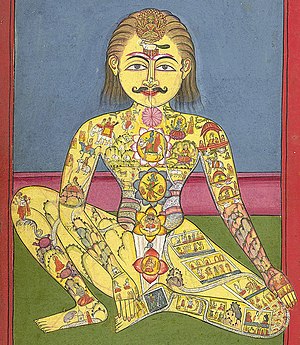
Back جسد لطيف Arabic সূক্ষ্ম শরীর Bengali/Bangla Energiekörper German شوکشما شریرا Persian Corps subtils French सूक्ष्म शरीर Hindi Finomtest Hungarian Corpo (esoterismo) Italian Subtilusis kūnas Lithuanian सूक्ष्म शरीर Marathi

A subtle body is a "quasi material"[1] aspect of the human body, being neither solely physical nor solely spiritual, according to various esoteric, occult, and mystical teachings. This contrasts with the mind–body dualism that has dominated Western thought. The subtle body is important in the Taoism of China and Dharmic religions such as Hinduism, Buddhism, and Jainism, mainly in the branches which focus on tantra and yoga, where it is known as the Sūkṣma-śarīra (Sanskrit: सूक्ष्म शरीर). However, while mostly associated with Asian cultures, non-dualistic approaches to the mind and body are found in many parts of the world.[1]
Subtle body concepts and practices can be identified as early as 2nd century BCE in Taoist texts found in the Mawangdui tombs.[1] It was "evidently present"[1] in Indian thought as early as the 4th to 1st century BCE when the Taittiriya Upanishad described the Panchakoshas, a series of five interpenetrating sheaths of the body.[2] A fully formed subtle body theory did not develop in India until the tantric movement that affected all its religions in the Middle Ages.[1] In Indo-Tibetan Buddhism, the correlation of the subtle body to the physical body is viewed differently according to school, lineage and scholar, but for completion stage in yoga, it is visualised within the body.[3] The subtle body consists of focal points, often called chakras, connected by channels, often called nadis, that convey subtle breath, often called prana. Through breathing and other exercises, a practitioner may direct the subtle breath to achieve supernormal powers, immortality, or liberation.
Subtle body in the Western tradition is called the body of light. The concept derives from the philosophy of Plato: the word 'astral' means 'of the stars'; thus the astral plane consists of the Seven Heavens of the classical planets. Neoplatonists Porphyry and Proclus elaborated on Plato's description of the starry nature of the human psyche. Throughout the Renaissance, philosophers and alchemists, healers including Paracelsus and his students, and natural scientists such as John Dee, continued to discuss the nature of the astral world intermediate between earth and the divine. The concept of the astral body or body of light was adopted by 19th and 20th-century ceremonial magicians.
The Theosophy movement was the first to translate the Sanskrit term as 'subtle body', although their use of the term is quite different from Indic usage as they synthesize Western and Eastern traditions. This makes the term problematic for modern scholars, especially as the Theosophist view often influences New Age and holistic medicine perspectives.[1] Western scientists have started to explore the subtle body concept in research on meditation.[4]
- ^ a b c d e f Samuel & Johnston 2013.
- ^ Mallinson & Singleton 2017.
- ^ "Tibetan Medicine and the Subtle Anatomy - Tibetan Medicine, Buddhism & Astrology - London". Shrīmālā | Tibetan Medicine, Buddhism & Astrology | London. 11 January 2020. Retrieved 2 April 2021.
- ^ Cite error: The named reference
Loizzo 2016was invoked but never defined (see the help page).
© MMXXIII Rich X Search. We shall prevail. All rights reserved. Rich X Search